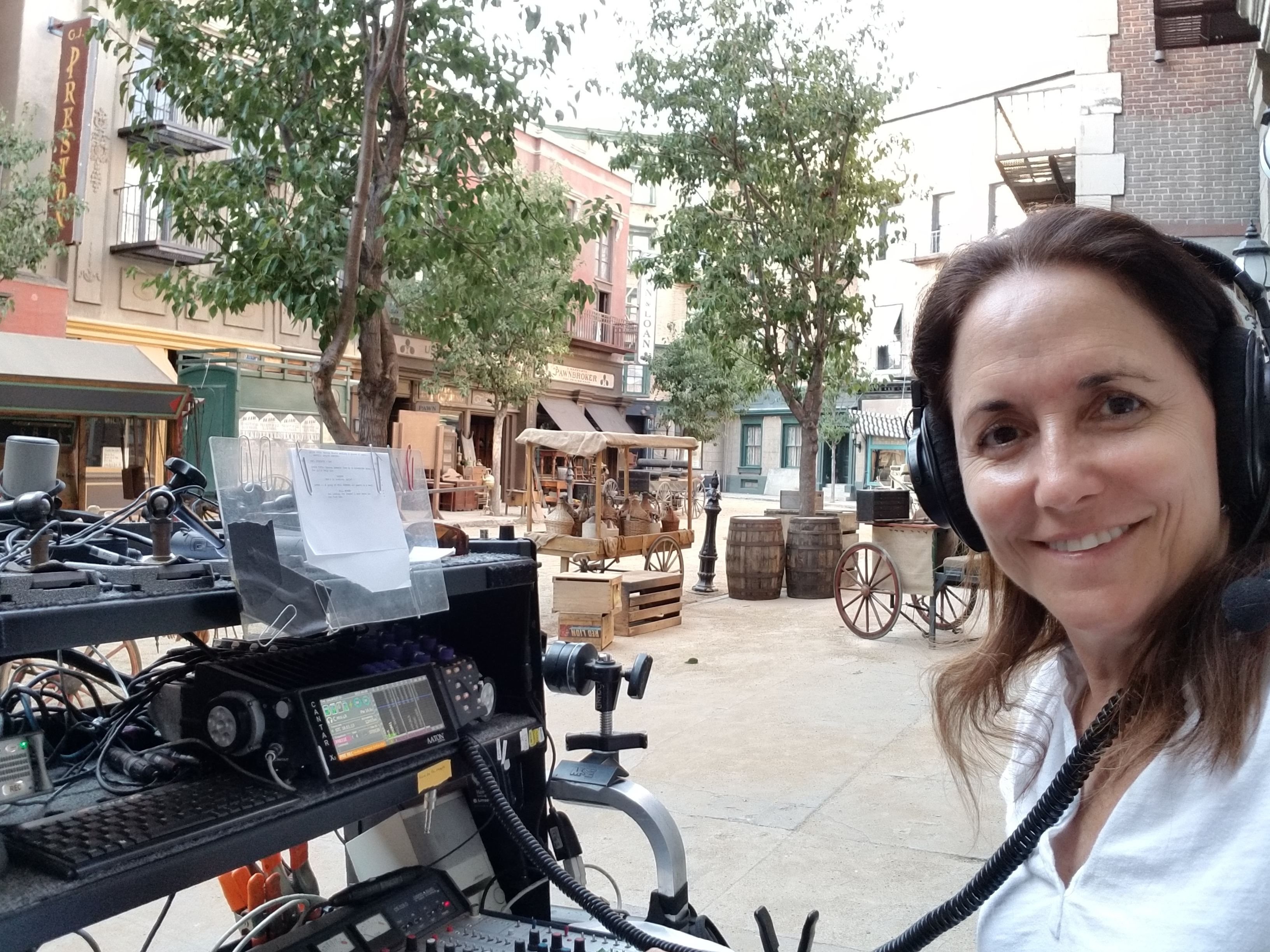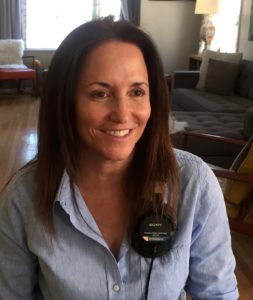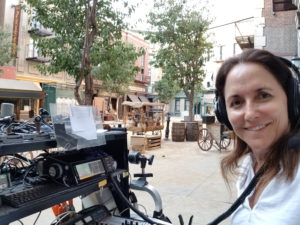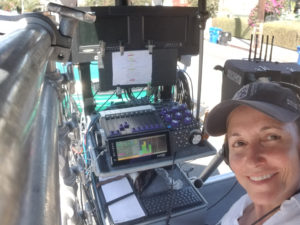
An Interview with Shawn Holden, CAS
Originally published in the CAS Quarterly Magazine, Fall 2017. Written by Devendra Cleary, CAS.
I was really excited to take on this assignment and speak to Shawn Holden. To do a bio on a heavy-hitting production sound mixer like her is an immense privilege. She is someone I’ve known for a long time and have a great deal of respect for.
We first met when she hired me to boom a short film called In the Morning, in 2005. And for how long I’ve known Shawn and the fact that we interface often, attend the same industry functions, serve on the Board of Directors of Local 695 together, I was embarrassed by how little I really knew about her and her amazing history in this business. I sat down with her at Tart in West Hollywood for a couple of hours. If it wasn’t for the fact that her next appointment for that day was to go buy a SECOND (!) Aaton Cantar X3 (no big deal), I could have chatted her up for several hours more.
Tell me about your roots and early history—before you entered “the biz.”
For the most part, I grew up in Oklahoma. My dad, with his job, we moved around until about the summer before fourth grade. And we landed in a small town of 25,000 people. Then I went to the University of Oklahoma. There were lots and lots of friends, we always had a band, we all played musical instruments. There was a lake nearby. You know, lots of time on the water. And I used to take a lot of pictures. And that’s what I went to school for. I was going to be a set still photographer.
You had that specificity of occupation in your head already?
I did and I knew I wanted to work [as a still photographer] in the movies or TV. I didn’t know what or how but I was really into photography. When I was older, I had a darkroom in my house. And that’s what I wanted to do.
There were a couple of movies that came through our hometown and I’d go and hang out and just watch. On one movie, I drove up to the gate and told them I was with the caterer. It was way out in the country and they were doing this big stunt. So I just hung around and ended up chatting up the really cute stunt guys. They told me how to do different things, [like] using the parking brake to do 180s and all the car stuff. I was already riding horses, riding motorcycles, riding unicycles, water skiing, snow skiing, you know, all the things that I was already doing, they needed. So they said, “Yeah, you gotta come to LA!” But in reality, I knew that was never going to happen. I went to the University of Oklahoma with a motion picture major to be a set still photographer.
About halfway through the curriculum, there was an opportunity to either go radio-TV-film or stay in motion picture. The University of Oklahoma—motion picture major? Yeah, not really well-known for its film school. But it’s become a good journalism school. What I did end up doing—I took a lot of classes in photography, the journalism department, as well as the art school. I went ahead and changed to radio-TV-film because I knew the opportunities were smarter. So I was doing an internship in Oklahoma City at a TV station. And there was a TV show called PM Magazine. It was like one of the first news magazine shows. You get a reel (from San Francisco, which I think was the base) and you had to fill the rest of the time with your local standup people or local stories that you produce. So by the time I left there, I was writing, shooting, producing, editing, and doing sound. It was [just] one of the many things I was doing there.
The head news photographer knew me at the station. They hired me after my internship and I worked about a year-and-a-half and then got laid off with about 10 other people. I decided to move to Dallas because they had built these stages. And it was going to be the third coast and all this stuff was going on. So, of course, I called everybody I knew—which was not many people —when I moved to Dallas. And one of the people was Darrell Barton, a cameraman. And out of the blue one morning, he called me and said, “Get to the airport as fast as you can.” In Mexico City, there had been a big earthquake. “Don’t pack. Don’t do anything. Just get to the airport.” So me being a dumb kid, I did exactly that. He said, “We’re just going to fly down, get there, and then we’re going to come fly back with the tape.” The tape! This is how long ago. “We’ll throw the tape over the fence if we have to.” So we did. Got on a little Learjet and flew to Acapulco where our pilots knew some air traffic control guys that they could bribe to let us into the Mexican airspace. Got to Mexico City—and I was working with Dan Rather! I was a network news sound technician. And that was that.

Shawn working hard at the top of the Hotel Artemis which looks a lot like the top of the Rosslyn. Photo: Matt Kennedy
Was that the first time you considered yourself with that title officially?
That was the first time on that level. Darrell and I worked together for a couple of years after that. He’d won ‘National Press Photographer of the Year’ twice. He was very, very good. We were connected then. We were tied together with cable. And I was carrying a deck when we first started. Three-quarter inch. And I was a pack mule more than anything. But I was one of maybe five or six women in the country doing it. At that time, there were very, very few of us because it was very physically demanding. So, because he was who he was, I was very lucky and got to work on some of the best stuff. We traveled around the world. I’ll never forget some of the times with Darrell. He was the kind of guy—he was a Marine in Vietnam—and he always had this cigarette hanging off his lip. You’d be walking through a field and there’d be a giant puddle of mud and if you walked five feet, you could step around the mud. JUST FIVE FEET! No, no!
Was network news sound the main focus then or were you still pursuing other ventures?
Well, when I first moved to Dallas, the photography thing was still going. I was working for a music magazine that’s sort of like LA Weekly. And I did concert photography. It was great. It was Madonna’s first tour and, I mean, I’ll never forget this—that’s the tour where the Beastie Boys opened for her and they got booed off the stage.
Oh, that’s funny! Seems outrageous from my perspective, growing up being such a fan of theirs.
In Dallas, nobody knew who they were.
They were probably thinking: “Who are these clowns?”
Yeah, exactly! But [photography] was something that was still there. I was still sort of doing it. But then this [sound] thing took off and then I was in the union. I was in two unions: IBEW and NABET. And, I’m a union sound technician. So it’s hard to step away from that. I was a kid making bank. I was traveling all over and I think I’ve been in every state but Alaska at this point. I still have my old field mixer, this mixer I still use! I still
have one that I went to Africa with. It went all kinds of places with me. I did that for so long. I did that for over 12 years. I kind of reached the peak of what I could do in that world. I have an Emmy and all kinds of things from doing that. And I met Simone. I met my partner of 22 years.
Doing that news magazine work during that time, that’s when you met her?
Yeah. There was a pilot for a news magazine show that never aired that was shooting outside of Dallas. I was still living in Dallas at the time. And they needed an all-female crew and there was a DP in New York that I’d worked with a lot, Alicia Webber. She was fantastic. And so she came down and a mutual friend of Simone’s had known Alicia and recommended Simone to come and gaff this thing.
Oh wow! I love hearing these stories of the coincidental meeting of people who become such permanent fixtures in our lives.
So anyway, we all met in Dallas. Doing this show.
That is truly amazing.
Yeah, it was, yeah.
Congratulations on 22 years together!
Yeah, it seems to have worked out! I sold my house nine months later and moved out here [Los Angeles]. I always wanted to work in the movies. I’d wanted to transition into doing that. And there were just no openings, really. I could have come out here not knowing anybody I guess. And when I first came out here, I continued to do some of the news stuff—also behind-the-scenes stuff, getting on a few movie sets. I knew Bob Wald. He helped me loads. He’s great. I could call and ask him all the stupid questions that you’re too embarrassed to ask anybody. Like you really don’t know? Just dumb things. He was really, really great.
Would you put Bob Wald in the mentor category?
Absolutely. I would put him and I would put Bill Kaplan in that category. Bill has been so super good to me over the years. He calls and he says, “This is your agent calling.” Yeah, he’s been super, super sweet.
I talk to Amanda Beggs often and I know he’s pretty good buds with her and she says a lot of the same things about him. Such a good guy and a huge help. Yeah, he’s been really good with her, too. And he’s that way. He’s just awesome. He’d always have me come do second units and just getting that exposure that’s needed, you know. And I’ll never forget this … It was many years ago. Somebody had called him about this movie in New Mexico and he wasn’t able to do it and he said he was going to give them my name. So he called and asked me about my availability. And I said okay, great. I’d love to go out and do it. Twenty minutes go by. He calls me back and he says I had no idea you being a woman was such a big deal. Well, when Bill Kaplan recommends you for something, people tend to listen. But I never heard a peep, not a peep from them. Well, as I said to Bill, welcome to my world. I mean, welcome to our world.
It’s so much better now. So much better because so many women—Amanda [Beggs], great example. There are so many women coming up and doing it and doing great work. And in many cases, even better, more meticulous and because when I first started, the few women that were doing it, you couldn’t say no to anything. Whatever you were doing, you had to wear that flak jacket and sneak up with the rest of everybody. You couldn’t complain about anything. You just had to do it or you better, by God, be good at it because if you’re not—I mean talk about the scrutiny. That was always in the back of your mind. We all had to step up. You had to really get it right. It’s bad enough sitting there with Mike Wallace, but to screw up, no, no, no. It wasn’t an option. It was an option, but you’d never ever be back. You’d never work again for those people, that company, because it was very easy for them not to want a girl.
You have an impressive list of feature film credits. Do you have a favorite movie title that you mixed that sticks out in your memory that you want to talk about?
There are two off the top of my head: Gods and Monstersway back when. It was such a great group of people and the acting was amazing and to be able to watch that happening with those actors was really amazing.
And then Nightcrawler. You know, we busted our asses on that movie and it was not easy. It was probably one of the hardest I’ve ever done. But I was proud of what we got in the end. I was proud of our work and that really, it paid off.
This movie I just finished, Hotel Artemis, I’m curious about how it’s going to turn out. Sometimes you really know when you’re there in the moment. There are a lot of visual effects that are going to be added and I just don’t know. But it was a really interesting movie with a great cast.
You’ve been in this industry for so long, starting in the news-gathering side and successfully transitioning to narrative-style production. So, as far as our equipment and our techniques go, and reflecting on how much it’s changed and where you are now, where do you see the future going? How do you think we’re going to expand further?
I’m saddened by the fact that it has gotten to where it is. And it started with television and multi-camera, not [necessarily] multi-camera shows, but “single-camera” shows that really have two and three cameras. Wides- and-tights at the same time. And so you’re expected to wire everybody on set no matter what. Sound used to have life. It, you know—breathed. You felt that if you see somebody across the room, you didn’t hear them speaking like they’re sitting next to you at this table. Perspective is out the window. And we do what we can. We try very hard. I was grateful on The Grinder, a TV show that I was doing, that number one on the call sheet refused to wear a wire. So when we were on stage, we didn’t use wires, but rarely. We used them like they’re supposed to be used, instead of how they expect you to use them now.
I have done more features in my career than television. But it’s bleeding into the feature world, as well. And it’s just … it’s devastating. I remember at that CAS [Awards] we were talking about Doc Kane, and he had called out The Grinder and about how it sounded. He thought it sounded great and it was amazing. And this is a man whose received a CAS Career Achievement Award! He should know. And that’s because we boomed the crap out of that show. I’m a sound mixer and it starts to become where you’re just a recordist. I do understand that with the amount of tracks that we’re being asked to do and the improv style of many of today’s shows, it becomes impossible to record it any other way, though.
Who are some of your crew that you’d want to give a shout-out to now?
Well, Tom Hartig did The Grinder with Yvette Marxer. They’re both wonderful. We had a great time on that. Doug Shamburger—Doug is amazing. And I had Doug and Michelle Guasto on my last movie. Fantastic. Those are two amazing, amazing people. I’ve had the great opportunity to work with some of the most wonderful boom ops and utilities in the business. I’d also love to give a shout-out to Randy Johnson, Bob Jackson, Anthony Ortiz, Peggy Names, as well as Ross Levy, just to name a few. On an upcoming pilot, Rebecca Chan is going to be my utility. We’ve never worked together but I’m thrilled she’s going to come. I understand she’s phenomenal.
I’ve been so lucky. I’ve been able to work with a lot of different people that are just really, really great. I wish I could keep them with me all the time and just go from one thing, to the next thing, to the next thing. We’re only as good as our crew. The difference between having that mic on and not is something. I know you feel the same way. Even with your utility. If I have to do their job, forget it. I can’t do that.
Absolutely right. Well, in conclusion, is there a solution that you think could start to remedy the conundrum of how our craft has changed?
I think it’s the reality and we just have to get really good at it and help educate. Because a lot of these people that are in positions of making decisions like that, aren’t educated [fully on sound]. And to some level, when you work with those people that get it, it’s just such a dream come true. They understand how important it is to the entire chain, the entire process. When you have something that sounds real and awesome, and you don’t have to fix it later, you don’t have to tweak the hell out of it. Because you start fixing too much and then it really starts to degrade what we’ve done.
People have gotten used to that sound, too, which is weird. You go back and you watch old movies—or even not [very] old movies. Just—where it breathes. It’s part of the life of the film. It has feeling to it. And now people are just so used to it just being right “here” all the time. It’s a buried “voiceover booth” sound with clothing noise. And so it’s just kind of a bummer. I mean it happens. We all often have to wire everybody all the time. You just have to. Environments and whatever it is. We all have to grow and adapt and learn. “Old dogs, new tricks.” But there is an artistry there that we can’t lose.
Republished with permission by the Cinema Audio Society. Thank you to Shawn Holden, Devendra Clearly, and Karol Urban for their assistance.



